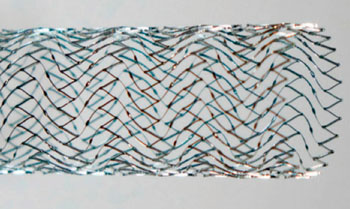Reinforced Stent Treats Venous Outflow Obstruction
By HospiMedica International staff writers
Posted on 18 Dec 2014
A new venous stent system conforms to the unique anatomy and pathophysiology of the venous system, including crush resistance, vessel coverage, and flexibility.Posted on 18 Dec 2014
The Vici Venous Stent System is intended for use in veins of the lower extremities and pelvis, including the iliac and common femoral veins, and in patients who exhibit symptomatic venous outflow obstruction. The system comprises two components: the stent implant itself and the disposable delivery system. The stent is a laser cut, self-expanding tube made of a nickel titanium alloy (nitinol) with closed-cell segments and proprietary bridges and braces, designed to provide strength and flexibility in the venous anatomy.

Image: The VICI Venous Stent System (Photo courtesy of Veniti).
Since venous disease requires a high degree of crush resistance, the radial stiffness of the venous stent is maximized to resist compression and improve vessel patency. The delivery system is a coaxial, over-the-wire (OTW) design with an exterior shaft to protect and constrain the stent prior to deployment. It is compatible with a 9F sheath introducer, and can be delivered via either a jugular or femoral vein approach. The Vici Venous Stent System is a product of Veniti (St. Louis, MO, USA), and has received the European Community CE marking of approval.
“The Veniti Vici venous stent appears to have the radial strength and vein coverage to provide optimal results in patients with symptomatic outflow obstruction of the lower extremities,” said Stephen Black, MD, a consultant vascular surgeon at St. George’s Vascular Institute (London, United Kingdom), who implanted Veniti Vici stents in five patients with symptomatic venous outflow obstruction of the lower extremities. “Having a stent that was designed from its inception for use in veins makes this an important addition to my treatment options.”
Symptomatic venous outflow obstruction of the iliofemoral vein is a common complication of deep vein thrombosis (DVT) and May-Thurner syndrome (MTS), which is caused when the left iliac vein is compressed by the right iliac artery, which increases the risk of DVT in the left extremity. Until the advent of stents, patients did not have many options, and were treated with compression stockings, by elevating the leg, or with different pharmaceutical agents.
Related Links:
Veniti














